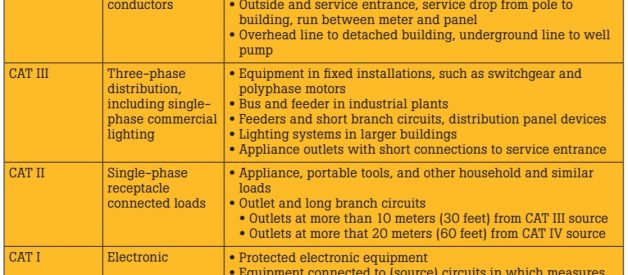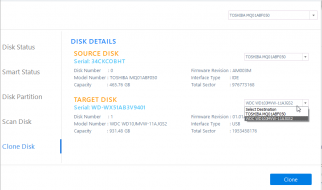 How to Use a Multimeter ? Multimeter Safety Tips
How to Use a Multimeter ? Multimeter Safety Tips
Multimeters are the most common piece of electrical test equipment. And as the name implies, it can measure a lot of variables such as voltage, resistance, current and many more.
While a digital multimeter can be a safety device and an efficient work tool in the hands of a trained technician, it can also be a source of electrical accidents in the hands of a careless or ignorant individual.
Using a multimeter efficiently and safely is probably the most important skill a technician or electrician can master, both for proficiency in their trade and their own personal safety.
Carelessness is the main factor that causes electrical accidents. And whether you are a professional technician or an electronics hobbyist, it is imperative that you follow the multimeter safety precautions to avoid tossing yourself into this unwanted situation.
How to Use a Multimeter Safely?
There are various models and brands of multimeters with each spotting different sets of features.
In this section, we will discuss how to use a multimeter for different applications safely. However, the illustrations used here is a generic design and not specific to any brand, but just to explain the basic usage principles.
How to Use a Multimeter to Measure Voltage?
On your digital multimeter, you will notice a rotary selector switch that can be set into three main measuring settings: Voltage ?V,? Resistance ??,? and Current ?A.?
The ?V? and ?A? settings are further divided into two unique positions with either a squiggly curve with a dashed line under it (which represents AC) or a pair of dashed and solid horizontal lines (DC).
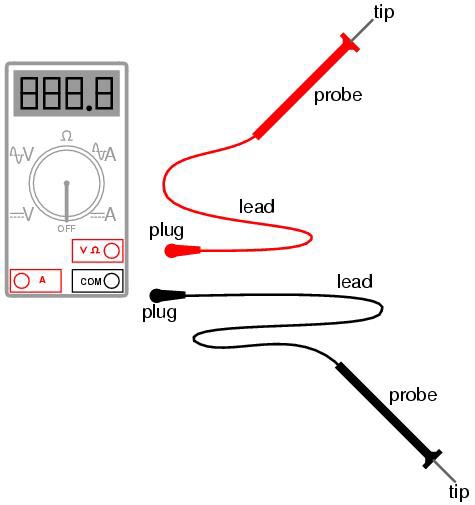 Measuring Voltage with a Digital Multimeter ? Image: allaboutcircuits.com
Measuring Voltage with a Digital Multimeter ? Image: allaboutcircuits.com
This makes a total of five positions, and you are required to select the type of current (A) or voltage (V) to be measured with the rotary selector.
To prevent error and electric shock, always bear this distinction in the meter settings in mind.
You will also notice the sockets on the device to which you can plug your test leads (the insulated black and red conductor with sharp and pointed probes).
Plug the black test lead into the socket marked ?COM? on your multimeter, and the red lead into the red socket marked for resistance and voltage, or the one marked for current based on the parameter you intend to measure.
Safety Tips to Measuring Voltage With a Multimeter
- You need to understand the quantity you want to measure and avoid putting the test lead into a wrong socket to avoid the risk of electric shock.
- Be mindful of the voltage you are measuring. When measuring AC voltage, for instance, do not allow the probe tips to touch one another when they are still connected to their respective point on the electrical circuit. This is to avoid shorting the circuit which can create a spark or ball of flame that can harm you.
 Avoid the probe tips from touching one another when connecting to electrical circuit ? Image: allaboutcircuits.com
Avoid the probe tips from touching one another when connecting to electrical circuit ? Image: allaboutcircuits.com
- Do not use your test leads if the protective insulation on the leads or probes is cracked or worn. Your fingers may touch the probe conductor, and this might result in a very bad shock.
- The movement of current from one hand to the other during an electric shock is the most dangerous. If possible, use a single hand to hold the probes or latch a probe tip onto the test point of the circuit so that you can hold the other in your hand and set it in place.
- Both DC and AC voltage can be very dangerous. Even if you are not expecting to find both, you should always perform safety check when using a multimeter by checking for the presence of both DC and AC voltages.
>>> See also: Best Multimeter For Electronics Review
How to Use a Multimeter to Measure Resistance?
Measuring resistance using a multimeter is a much simpler task.
- Place the probes in the right sockets (black test in ?COM? marked socket and the red test in the red socket marked for resistance).
- Turn the selector switch to ??? and touch the probes across the device you intend to measure to display the readings on your meter.
However, you should always remember that the measurement of resistance should be done only on a de-energized component.
This is because a meter set to the resistant mode uses a small internal battery to move some tiny current through the component you intend to measure. The difficulty in moving these currents through the component is then recorded and displayed as the resistance by the meter.
If there is an added source of voltage or the circuit is energized, the meter will produce faulty readings. In some cases, this additional voltage may damage the meter.
How to Use A Multimeter to Measure Current?
This application of multimeters is the most complex and hazardous. The reason for this is not farfetched; it is because you must force the current you intend to measure to pass through the meter.
It means that you will not just connect the meter somewhere off to the side like you?ll do when measuring voltage but will rather make your multimeter a part of the current path of the circuit.
To achieve this, you must break the original circuit and connect the meter across the two points of the open break.
To measure current, you have to set your meter to point to AC or DC ?A? using the selector switch, and plug your red test lead into the socket marked ?A.? The illustration below shows how to measure current in a circuit.
 Measure currents using a multimeter ? Image: allaboutcircuits.com
Measure currents using a multimeter ? Image: allaboutcircuits.com
Break the battery-lamp circuit and connect the multimeter probes to the broken ends of the circuit. (connect the red probe to the end of the wire that leads to the lamp and the black probe to the ?-ve? terminal of the battery to read the current).
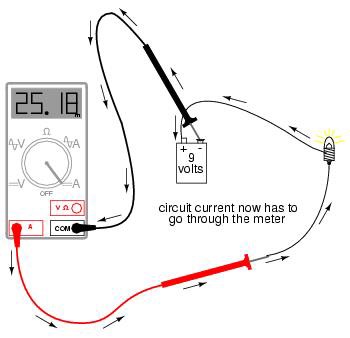 Connect the probes to the circuit to measure current ? Image: allaboutcircuits.com
Connect the probes to the circuit to measure current ? Image: allaboutcircuits.com
The circuit in this illustration has a 9-volt power which hardly results in an electrical accident, and so it is safe to break the circuit open with your bare hands.
But it could be very dangerous if you try this when you are working with higher power circuits. Even if the voltage in the circuit is low, the current flowing through it could be high enough to cause an injurious spark once you establish the last meter probe connection.
Another possible cause of electrical accidents when using the meter is the failure to remove it from its current-measuring mode and return it back to the normal voltage-measuring configuration before you measure voltage with it.
Of course, it is easy to set the selector switch from the current to the voltage position and forget to change the position of the red test led from Ampere to Voltage. The meter will impede the flow of electrons within the circuit which will then result in a short circuit within the meter.
Some meters come with a warning feature and beep whenever a test lead is plugged into the ?A? socket while the selector switch is pointing towards the voltage position.
As good as these features can be, they are not a replacement for thinking clearly and following the necessary safety precautions when working with a digital multimeter.
Best Safety Tips For Using a Multimeter
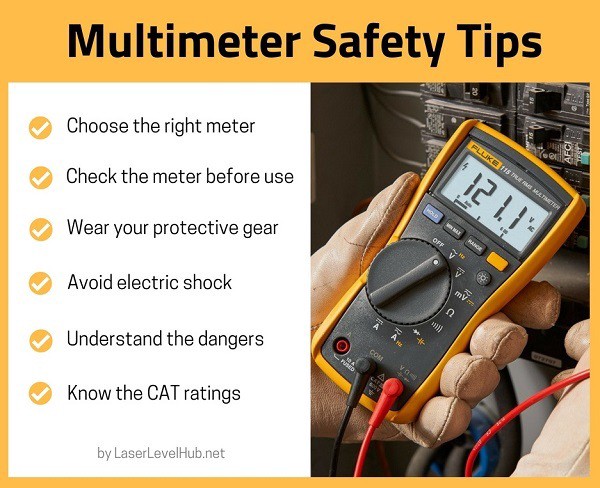 Multimeter Safety Tips
Multimeter Safety Tips
Tip 1: Choose the Right Meter
It is very important to select the multimeter that can handle your job. This helps to avoid error, damaging the meter or electrical accidents.
Always go for a meter that is suitable for your measurement location and has the highest CAT ratings in which it could potentially be used or one with a rating that is higher than what you require.
For instance, if you want to measure an electrical distribution panel with 500 V, use a meter with CAT IV-600 V, CAT-III-1000 V, or CAT III-600 V.
>>> Read more: What is The Best Multimeter For Beginners?
Tip 2: Examine The Meter Before Using It
- Start by looking for the signs of physical damage.
- Do not assume the multimeter is in a good working condition. You should check if it is working properly before you work on a high-energy live circuit. Use a proving unit or a known voltage source.
- After use, disconnect the test probes and store the unit and its accessories in a protective case.
Tip 3: Examine The Test Probes
- Start by physically inspecting the probes, ensure that are shrouded and are not worn, cracked or damaged.
- Ensure that the connection should be firm and secure when you insert them into the jacks.
- Make sure the test lead metals are minimally exposed at the tip to avoid electrical shorting.
- Do not use a damaged test probe or attempt to repair it. Damaged probes must be replaced.
Tip 4: Avoid Electric Shock
Electric shock happens when the body of the operator becomes part of an electrical circuit. For this reason, you should always assume that all the component of an electrical circuit is energized.
You should also be aware of the positioning of your body when you find yourself in electrical environments.
The seriousness of an electric shock depends on:
- The amount of current flowing through the circuit
- How long the body is exposed to the flow of current
- The area exposed to the contact and the path through which the current flows
- The condition of the exposed region to the current (for instance, dry hands have more resistance to current flow than wet hands).
To avoid electric shock, follow the below tips:
- Make use of your personal protective materials. Wear your gloves, and headwear, and use the insulated rubber mats when working near energized or on electrical circuits that are 50 V or greater.
- When working near or on energized or exposed circuit, do not work alone.
- Avoid operating the meter in damp or humid environments.
- Watch for the audio or visual warnings in your multimeter display unit.
Tip 5: Understand The Dangers
Transient overvoltage (power surge): This is a brief, unwanted, erratic spike in energy that can amount up to thousands of volts. Lightning strikes, switching power on and off, motors and unfiltered electrical equipment are the prime generators of spikes. Transient overvoltage is an almost inevitable danger of testing electrical gadgets.
Arc blasts, arc flashes: these are the current discharge across an air gap. They are caused by a) accidental contact between conductors or b) excess voltage ionizing the air between the conductors.
Note: Arc blast or flash can occur in an electrical system when a power line transient happens as a multimeter is used to record the voltage. CAT-rated multimeters are made to reduce, lower or forestall the occurrence of this situation within the meter.
Tip 6: Know the CAT Ratings
CAT rating is the magnitude of the temporary power spike that a meter can withstand.
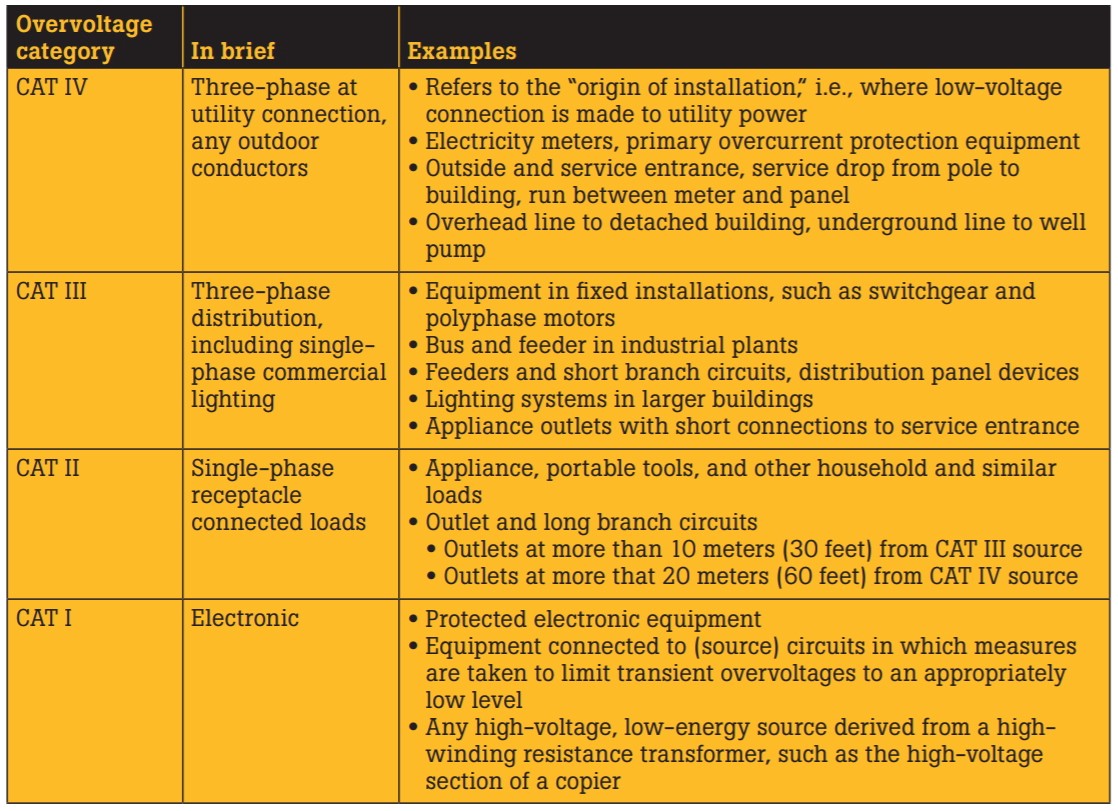 Overvoltage category or CAT Ratings ? Source: ABCs of multimeter safety ? Fluke
Overvoltage category or CAT Ratings ? Source: ABCs of multimeter safety ? Fluke
- The CAT categories depend on the fact that a hazardous high energy spike such as lightning strike will be dampened or attenuated as it moves through the impedance of an electrical gadget.
- The key to CAT ratings is the location. As an energy spike (transient) moves through an electrical system, the ac resistance (impedance) will reduce it.
- Typically, the nearer you are to a source of power, the higher a CAT number will be, which means the higher the potential energy transients the electrical environment has. A meter with CAT IV ratings is more resistant to higher energy transients than one with CAT III standards.
Tip 7: Know The Voltage Ratings
A higher voltage rating within a CAT category represents the ability to withstand higher energy spikes.
For instance, a CAT III-1000 V multimeter has higher protection than a CAT III-600 V multimeter. Whereas a CAT III-600 V meter offers more protection than a CAT II-1000 V.
Find more digital multimeter reviews and using tips here
Conclusion
A multimeter can be a safety device and an efficient work tool especially in the hands of an experienced technician. While this tool can efficiently measure some electrical parameters, detect electrical faults, and enhance your proficiency at your trade, it could also be a source of electrical accidents if you are careless or ignorant.
This article has shown you some factors that cause electric accidents, and how you can use your multimeter and avoid the unwanted situations.
Why not follow these safety precautions and bid goodbye to the potential hazards associated with your tool?
Remember, you have more to gain than to lose.
